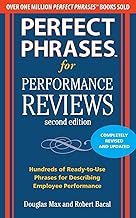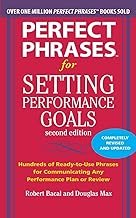Using This Book to Write Better Performance Goals - Free Book Excerpt From Perfect Phrases for Setting Performance Goals
Before we start you on the path to writing better performance goals and
before we explain how to use this book to help improve both individual
work performance and overall performance of your work unit or company,
we need to place performance goals within the business and management
context and examine why it's important to take the time to establish performance
goals for employees.
After all, if you don't see the sense or value in working with employees
to set goals, it's not likely you're going to do it. And employees also
need to understand what goals are, how they can be used, and, most importantly,
what value there is in having them.
What Are Performance Goals Used For?
There's a popular misconception that the way to improve performance,
whether on an individual basis or for a work unit, is to appraise and
evaluate it after the fact. You're probably familiar with the performance
appraisal process that is often used once a year. Manager and employee
sit down to discuss and evaluate performance for the past year.Some forms
are used to record the
conversation. Sometimes the process goes smoothly and sometimes not. More
often than not, the appraisal meetings do little to meet the needs of
the employee or the manager and neither considers them helpful. Or worse,
they dread them.
Performance appraisals can be valuable, but not on their own. In fact,
the many benefits of managing and appraising performance are lost when
managers focus solely on the appraisal process or the end point. It's
like driving while looking in the rearview mirror: you see what's already
past and beyond your control. If we want to improve performance, we need
a forwardlooking process so we prevent performance problems. And we need
some way of harnessing and coordinating the work of individual employees
so we increase the effectiveness of the work unit and the company in general.
After all, that's what we really want-for each employee to contribute
to the effectiveness of the whole.
The secret of success-for organizations, managers, and employees-is to
put more emphasis on making sure every employee and every manager knows
what he or she needs to accomplish in the present and future.When an employee
understands what he or she needs to do to succeed, it's much easier to
contribute. It's also much easier for managers to do their jobs, to improve
productivity, and to manage proactively, rather than have to spend time
stamping out small fires after the fact. Clear purpose helps everyone
succeed and, bottom line, that's what we all want.
Enter performance goals. Like the bull's-eye on an archery target, performance
goals specify what the employee needs to aim at. Let's look at how they
can help.
For the Organization
To succeed, organizations need to be able to coordinate the work of individual
employees and work units, so that everyone is pulling in the same direction.
Performance goals provide the foundation to allow this kind of coordination
to occur.
The process of setting individual performance goals provides the mechanism
for translating the goals of the organization as a whole into smaller
chunks that are then assigned or delegated to individual employees.That's
necessary because organizations achieve their overall goals to the extent
that each employee does his or her part in completing the right job tasks
in effective ways.
For the Manager
It's easy to think about performance management and goal setting as"overhead."In
a world where many managers are exceedingly busy, there's a tendency to
think that performance management and goal setting are simply a paper
chase that has little to do with the manager's life.
That's not true. Yes, the process takes time and effort. What's easy to
miss is that goal setting is an investment that pays off through higher
productivity. Let's look at how properly set goals help managers.
First, most managers want employees to do their jobs with a minimum of
direct supervision. Employees who require constant guidance and direction
eat up a lot of managerial time.Where do performance goals fit? When an
employee knows what he or she needs to accomplish and what is expected,
it's a lot easier for that employee to work without constant supervision.
Also, by helping employees understand how their individual work contributes
to the overall goals of the organization, we enable them to make their
own decisions about how to spend their work time so that their work is
consistent with the priorities of the organization. The result? The employees
know what they must do, how well they must do it, and why they are doing
it. That means there's much less need for ongoing supervision. Also, clear
performance goals allow managers to empower their staff to make decisions
relevant to their work without having to consult the manager on every
little question.
Second, clear goals allow employees to monitor their own progress all
year 'round and correct their efforts as necessary. If employees know
what they need to accomplish, they can look at their results as they go
and identify barriers to achieving those goals. Once again, this ability
to self-monitor and self-correct means less managerial time is needed
to supervise and guide employees.
Third, the performance appraisal/review becomes much easier, causes far
less anxiety, and goes much faster when there are clear performance goals.
In fact, the better the performance goals,the clearer they are and the
more measurable they are,the less managers and employees have to venture
into the realm of vague opinions about performance during the appraisal
process.Combine this with the fact that performance goals allow employees
to monitor their efforts and the results throughout the year and we get
an appraisal process that is much more effective and yields no surprises
for the employee.
Finally, let's consider the value of performance goals in helping to proactively
identify barriers to performance. It does little good to identify poor
performance after the fact or after it has affected the organization.
Clear performance goals make it much easier to monitor performance throughout
the year and catch situations where performance may be veering off course.
Then what follows is a diagnostic process in which employee and manager
can figure out what might be causing performance deficits and take action
early. In other words, the goals serve as the basis for an "early
warning system," because they are specific enough to allow employee
and manager to gauge progress all year long.
For the Employee
Most employees want and need to know four things about their work so
they can contribute and feel comfortable about where they are in the organization:
• What do I need to accomplish?
• Why am I doing what I'm doing?
• How well must I do it?
• How am I doing?
Job descriptions are of some help in outlining what an employee needs
to accomplish, but usually don't specify the "how well" part.
Performance appraisals can provide information about how an employee is
doing, but they are usually not done often enough to provide enough information.
Ideally, performance goals specify what accomplishments are necessary
and how well the work should be done. They are much more specific than
job descriptions.This helps the employee have a better understanding of
his or her job.That's always a good thing. The more an employee understands
the job, the more likely he or she can contribute.
Of course, employees want to know how they are doing. As we mentioned
earlier regarding the organization and the manager, clear performance
goals help employees to monitor their efforts and assess their results
during the year and provide a basis for performance appraisals and reviews.The
goals can also serve as a basis for ongoing discussion between manager
and employee or,forthat matter,among employees,aimed at improving work
contributions. Employees can receive recognition for accomplishments throughout
the year, since it's easy to identify when an employee has met or exceeded
a performance goal.
The bottom line here is that performance goals help employees know where
they need to go and what they need to do to get there and help them determine
how they are doing.
Where Do Performance Goals Come From?
Performance goals don't appear out of the blue and they aren't created
from nothing. Where do they come from?
Since performance goals are used to coordinate and aim employees so they
can contribute to the overall performance of the organizations, they need
to link to the goals of the organization. Performance goals can't result
in better performance unless they are derived from the goals and priorities
of the work unit and the company. We recommend that performance goals
be based upon the needs of the organization. That's where they must originate
to be most effective. (In the next chapter, we'll map out the sequence
that links individual goals to organizational goals.)
It's not uncommon for managers to pull or generate performance goals from
job descriptions. That's not a good idea. Job descriptions are notorious
for being out of date and far too general to provide meaningful yearly
goals for employees. Also, they do not take into account the individual
strengths and weaknesses of any particular employee, since they don't
describe people, but positions. Job descriptions may be useful as background
material for setting goals, but keep in mind that it's quite possible,
and even desirable, for different people in the same position, with the
same job description, to have somewhat different goals.
Finally, individual performance goals develop from corporate goals through
discussion and dialogue between the manager and each employee. The goals
are set and negotiated individually and collaboratively. They are not
imposed, dictated, or "given" to the employee. Why? Here are
the main reasons:
1. Most employees-those who have been in their positions for a while-know
how they can best contribute. They know their jobs and how well they need
to do them. Employees are in the best positions to set goals for themselves.
2. Since we want employees to buy into the goals and treat them as most
important, they need to participate in the specification of the goals
that apply to them. When people are active participants in setting goals,
they tend to work harder to achieve them, since they have a feeling of
ownership.
3. Performance goals, by themselves, are important, but so are the discussions
that generate them. As you will see later, the discussion between manager
and employee serves many purposes, the least of which involves writing
down goals. The discussion helps employees understand where they fit in
the organization and provides meaning and con text for their work. It
helps employees understand the importance and the larger purpose of their
work. We know that when employees feel their work has meaning, they tend
to be much more motivated and diligent in their efforts to achieve those
goals.
So, to summarize, performance goals are based on the needs of the organization
and are generated through discussion and dialogue with employees. If you
skip or gloss over the dialogue, the process becomes less meaningful and
more a paper chase.
How to Use This Book
Developing performance goals isn't easy. It requires an investment of
time and effort by the manager and each employee. The purpose of this
book is to make the process a bit shorter, less frustrating, and easier
for all parties.
The book is organized into two parts.The first part is this one. READ
IT! Don't simply assume that you know what's in the first part, since
it's absolutely critical that you understand the details of performance
goals and goal setting.We'II provide those to you and map out how to go
about setting goals so they work and how to go about using the goals you've
set.
Once you've read this first part, you'll be ready to make use of the goal
phrases in this book.You can use it in several ways.
First, you can use the statements in this book "as is," to the
extent that they fit your situation. We've tried to generate goal phrases
that will fit a wide variety of jobs and job responsibilities and we've
categorized them to make them easy to find. However, you must make sure
that the goals you use reflect your situation, your company, and the needs
of company, management, and employee. So that means you may need to customize
extensively.
Second, you may find that one of the strengths of this book is that it
can stimulate employee and management thinking about goal setting. These
phrases provide good starting points for reflection and discussion. Just
keep in mind the point-performance improvement and coordination.
Generally, we suggest that you use this book prior to sitting down with
employees to set goals. Before meeting with each employee, take a few
minutes to go through the sections you think are relevant to him or her
and take note or jot down any goals you think may be applicable.
Consider sharing the book with employees beforehand. To reduce the time
you spend in goal-setting meetings, you can provide a copy of this book
to the employee and ask him or her to go through and identify a certain
number of goals-let's say, 10-15 goals-that might fit his or her job.
This will work only if the employee understands the job well and also
understands where your work unit and company are going in the next year,
so consider spending a few minutes with the employee before the goal-setting
meeting to discuss those issues.
What's Next?
Now that we've covered some of the basics, we'll guide you step by step
through the goal-setting process and provide you with valuable suggestions
for ensuring that everyone benefits from the investment in goal setting.
Learn more about Perfect Phrases
for Setting Performance Goals




